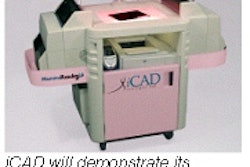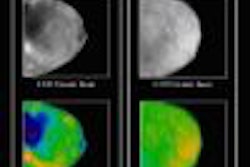“The gel mark is a catheter-delivered marker, which consists of seven air-impregnated gelatin pledgets, the center pledget containing a metallic marker. To give you an idea how it’s used and deployed, you put it through the distal aspect of the Mammotome probe, through the specimen collection chamber and it seats automatically at the end of the probe. The aperture is lined up with the Mammotome aperture and when the plunger is depressed, the pledgets are deposited into the biopsy cavity, ”said Parker, who is a shareholder in SenoRx, which manufactures the gel marker, and Johnson & Johnson, makers of the Mammotome system.
For this study, 110 gel markers were placed in women who underwent 11-gauge directional vacuum-assisted biopsy (DVAB). The gel markers were followed for a minimum of six months. The location of the gel marker on the follow-up mammogram was compared to the marker location on the immediate post-biopsy mammogram as well as the original breast images of the lesion.
The difference between the two locations in each instance was measured and recorded; the mammogram also was evaluated for the presence of pseudo-lesion at the gel marker site.
“We employed a mask, which was a clear film, placed on the original mammogram that had the lesion. We marked the lesion site on that mask. That mask was then placed immediately on the post-biopsy mammogram and the long-term follow-up mammogram. The distance of the marker from the lesion was measured in each case,” Parker explained.
According to the results, the marker demonstrated a median displacement of 4 mm compared with its locations immediately after the biopsy.
The marker was noted to be further from the original lesions in 32% of the cases and closer to it in 6%.
No potentially clinically meaningful interval displacement of greater than 24 mm was observed, Parker said. However, the original deployment error measurement, plus the interval displacement measurement, exceeded 24 mm in 3% of the cases. This percentage was still less than the 7% reported for conventional clip markers, he added. No mammographic pseudo-lesions were associated with the gel marker.
While the gel marker appears to be sufficiently stable, the issue of marker movement in general has yet to be solved, Parker said.
“So what’s going on with (marker movement)? I’m not sure anybody knows. I clearly believe that we may have underestimated the amount of apparent (marker) movement that is due to positioning (on mammography) and differences in positioning,” he said.
An audience member asked if the gel marker, which can be intensely echogenic, interfered with imaging local recurrence.
“There are actually two varieties of the gel mark now. The variety that we were following here maintained its echogenicity for only about three weeks,” Parker said. “There is another variety that lasts for eight weeks.”
By Shalmali Pal
AuntMinnie.com staff writer
December 5, 2002
Copyright © 2002 AuntMinnie.com



















